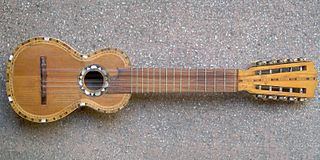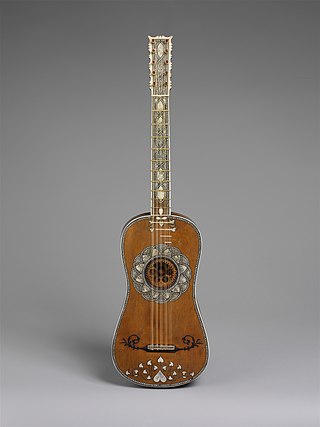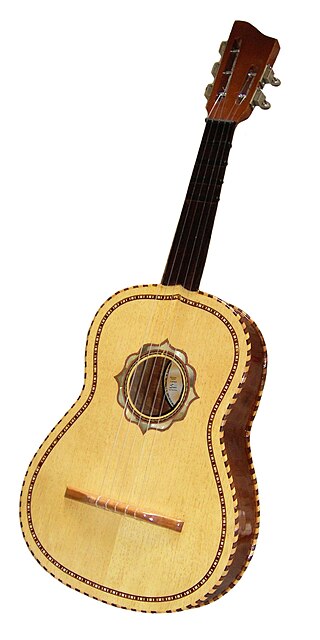
The classical guitar is a member of the guitar family used in classical music and other styles. An acoustic wooden string instrument with strings made of gut or nylon, it is a precursor of the modern steel-string acoustic and electric guitars, both of which use metal strings. Classical guitars derive from the Spanish vihuela and gittern of the 15th and 16th century. Those instruments evolved into the 17th and 18th-century baroque guitar—and by the mid-19th century, early forms of the modern classical guitar. Today's modern classical guitar was established by the late designs of the 19th-century Spanish luthier, Antonio Torres Jurado.

The guitar is a fretted musical instrument that typically has six strings. It is usually held flat against the player's body and played by strumming or plucking the strings with the dominant hand, while simultaneously pressing selected strings against frets with the fingers of the opposite hand. A plectrum or individual finger picks may also be used to strike the strings. The sound of the guitar is projected either acoustically, by means of a resonant chamber on the instrument, or amplified by an electronic pickup and an amplifier.

The charango is a small Andean stringed instrument of the lute family, from the Quechua and Aymara populations in the territory of the Altiplano in post-Colonial times, after European stringed instruments were introduced by the Spanish during colonialization. The instrument is widespread throughout the Andean regions of Bolivia, Peru, Ecuador, northern Chile and northwestern Argentina, where it is a popular musical instrument that exists in many variant forms.
Peruvian music is an amalgamation of sounds and styles drawing on Peru's Andean, Spanish, and African roots. Andean influences can perhaps be best heard in wind instruments and the shape of the melodies, while the African influences can be heard in the rhythm and percussion instruments, and European influences can be heard in the harmonies and stringed instruments. Pre-Columbian Andean music was played on drums and string instruments, like the European pipe and tabor tradition. Andean tritonic and pentatonic scales were elaborated during the colonial period into hexatonic, and in some cases, diatonic scales.

The vihuela is a 15th-century fretted plucked Spanish string instrument, shaped like a guitar but tuned like a lute. It was used in 15th- and 16th-century Spain as the equivalent of the lute in Italy and has a large resultant repertory. There were usually five or six doubled strings.

Paracho de Verduzco is a small city located in Michoacán, Mexico. Located about 100 kilometers west of the state capital Morelia, it serves as the municipal seat for the surrounding municipality of Paracho. It has a population of 37,464.

Bajo sexto is a Mexican string instrument from the guitar family with 12 strings in six double courses. A closely related instrument is the bajo quinto which has 10 strings in five double courses.

A course, on a stringed musical instrument, is either one string or two or more adjacent strings that are closely spaced relative to the other strings, and typically played as a single string. The strings in each multiple-string course are typically tuned in unison or an octave.
The cuatro is a family of Latin American string instruments played in Puerto Rico, Venezuela and other Latin American countries. It is derived from the Spanish guitar. Although some have viola-like shapes, most cuatros resemble a small to mid-sized classical guitar. In Puerto Rico and Venezuela, the cuatro is an ensemble instrument for secular and religious music, and is played at parties and traditional gatherings.

The Baroque guitar is a string instrument with five courses of gut strings and moveable gut frets. The first course sometimes used only a single string.
The evolution of classical guitars began with the influences of the vihuela and gittern in the 16th century and ended with the modern classical guitar in the mid-19th century.

An acoustic guitar is a musical instrument in the string family. When a string is plucked, its vibration is transmitted from the bridge, resonating throughout the top of the guitar. It is also transmitted to the side and back of the instrument, resonating through the air in the body, and producing sound from the sound hole. The original, general term for this stringed instrument is guitar, and the retronym 'acoustic guitar' distinguishes it from an electric guitar, which relies on electronic amplification. Typically, a guitar's body is a sound box, of which the top side serves as a sound board that enhances the vibration sounds of the strings. In standard tuning the guitar's six strings are tuned (low to high) E2 A2 D3 G3 B3 E4.

The Mexican vihuela[biˈwe.la] is a guitar-like string instrument from 19th-century Mexico with five strings and typically played in mariachi groups.

There are many varieties of ten-string guitar, including:

The Puerto Rican cuatro is the national instrument of Puerto Rico. It belongs to the lute family of string instruments, and is guitar-like in function, but with a shape closer to that of the violin. The word cuatro means "four", which was the total number of strings of the earliest Puerto Rican instrument known by the cuatro name.

The rondalla is an ensemble of stringed instruments played with the plectrum or pick and generally known as plectrum instruments. It originated in Medieval Spain, especially in the ancient Crown of Aragon: Catalonia, Aragon, Murcia, and Valencia. The tradition was later taken to Spanish America and the Philippines. The word rondalla is from the Spanish ronda, meaning "serenade."

The Concheros dance, also known as the dance of the Chichimecas, Aztecas and Mexicas, is an important traditional dance and ceremony which has been performed in Mexico since early in the colonial period. It presents syncretic features both pre-Hispanic and Christian. The dance has strong visual markers of its pre-Hispanic roots with feathered regalia, indigenous dance steps and indigenous instruments such as drums. However, the name Concheros comes from a type of lute made with an armadillo shell, showing Spanish influence. The dance in its current form was the adaptation of the old "mitote" dance to Catholicism as a means of preserving some aspects of indigenous rite. It remained a purely religious ceremony until the mid 20th century when political and social changes in Mexico also gave it cultural significance as a folk dance. Since the later 20th century, a sub group of the dance called Mexicas has emerged with the aim of eliminating the European influence, often with political aims. This form of the dance migrated to the United States in the mid-1970s and can be seen in states such as California in Mexican American communities.

Lutes are stringed musical instruments that include a body and "a neck which serves both as a handle and as a means of stretching the strings beyond the body".

Following its invention and development in Italy the mandolin spread throughout the European continent. The instrument was primarily used in a classical tradition with mandolin orchestras, so called Estudiantinas or in Germany Zupforchestern, appearing in many cities. Following this continental popularity of the mandolin family, local traditions appeared outside Europe in the Americas and in Japan. Travelling mandolin virtuosi like Carlo Curti, Giuseppe Pettine, Raffaele Calace and Silvio Ranieri contributed to the mandolin becoming a "fad" instrument in the early 20th century. This "mandolin craze" was fading by the 1930s, but just as this practice was falling into disuse, the mandolin found a new niche in American country, old-time music, bluegrass and folk music. More recently, the Baroque and Classical mandolin repertory and styles have benefited from the raised awareness of and interest in Early music.






















